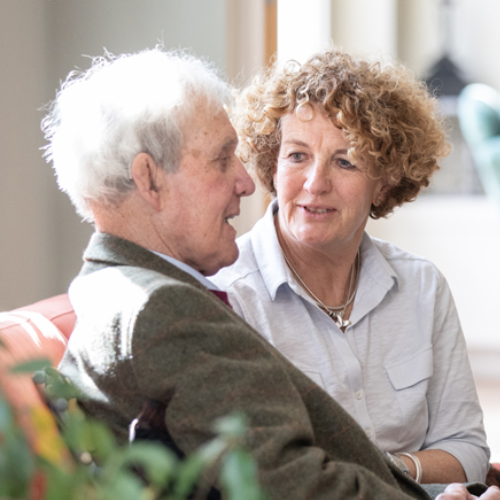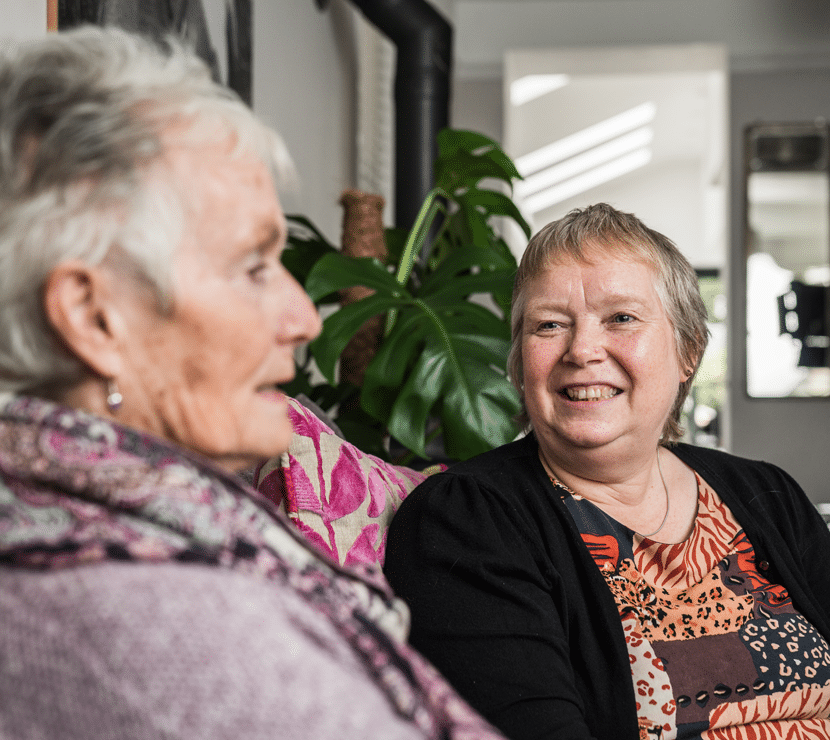Live-in care is the safer option
The recent pandemic has highlighted the potential risk that care home settings pose to elderly residents. At Oxford Aunts we are always looking for opportunities to improve our clients quality of life and even more so during these unprecedented times.
A recent survey by the Live-In Care Hub found that 29.3% of care home residents deaths were related to COVID-19 compared to live-in care where only 0.17% of deaths were attributed to COVID-19 or a related illness.
Here at Oxford Aunts we are proud to say we have had a 0.02% rate of infection, transmission or death within our client and carer community as a result of the strict infection control measures implemented at the beginning of the pandemic.
The Difference Between Home Care And Care Homes
Care homes provide care and accommodation for people with advanced care needs. Care homes often fall into two categories: nursing and residential.
Residential homes provide their residents with accommodation and support with the day-to-day tasks of living such as help during mealtimes, bathing and dressing. Those living in care homes have their own bedroom and bathroom while sharing other common areas. For the safety and comfort of residents, residential homes adhere to strict schedules for meals and social activities. Many residential homes can provide some medical attention, but they may not be equipped to handle specialist care needs.
Nursing homes also provide these services but they must also have at least one registered nurse on hand to help with more acute care needs. Care is planned and supported by nurses while much of the hands-on support is provided by care assistants.
Home care is support provided by a professional carer in the client’s own home. This type of care can vary from as little as one weekly visit all the way up to a live-in care arrangement where the carer lives with their client. A home carer can provide help with a number of day-to-day tasks ranging from sensitive personal care to domestic chores and pet care.
While residential and nursing homes provide a sense of safety and security and foster a real sense of community, the lack of independence can feel stifling for many people. Home care allows you to receive the care you need while maintaining the lifestyle you are used to.
The Benefits of Staying in Your Home
There are countless benefits to receiving care in your own home including:
- Receive tailored, one-to-one support that is difficult to achieve in a care home setting
- The ability to stay in your home and continue to enjoy your preferred lifestyle
- Familiar surroundings provide comfort and reassurance for those living with complex needs
- No upheaval or upset about leaving your home
- Couples can continue living together while receiving the care they need
- Continuing to be part of the local community you have loved
- Companionship and emotional support, should you need it
- Continue enjoying the company of beloved pets
- The cost is comparable to other types of care
- Reassurance to family members who want to know you are receiving the very best care
The Different Types of Home Care
There are several types of live-in care and hourly care available including:
- Live-in care – is when an experienced and dedicated carer comes and lives with you in your home. Live-in carers tprovide you with all the care and support you need to carry out everyday activities, with as much independence, choice and dignity as possible.
- Hourly care – is when a carer visits your home throughout the day to provide additional support with day-to-day life. We can provide a range of personalised hourly care services through Prestige Nursing & Care, part of our family of UK leading home care brands.
- Respite care – is a short term care package that means a person can be cared for in their beloved home by a dedicated and experienced carer. Respite care allows family carers time away from their role of caring to catch up and protect their own wellbeing.
- 24-hour live-in care – for when a person needs 24-hour support because ageing and health limitations mean they need around the clock care to continue to have a good quality of life.
Case Studies
Case Study 1
Mr G was 88 years old living in a care home with Parkinson’s disease and Lewy Body dementia. Although his mobility was reduced, he was able to transfer from chair to chair with the support of two carers and equipment. He appeared to have given up, was not eating or drinking and he was diagnosed as being at the end of his life. Mr G wanted to go home and was encouraged by his wife, who was missing him and was desperate for him to return home so they could spend his last days together.
Oxford Aunts Assessor, Amanda, was unable to visit the care home initially due to Covid-19 restrictions so she visited the family home to check it was appropriate and spoke to the Care Home Manager to assess Mr G’s needs over the phone. Before we could provide care, it was agreed that:
- There should be an OT assessment to make sure there was suitable equipment in place
- A SALT assessment would be completed
he report from the Parkinson’s Nurse should be checked, Amanda explained the steps that were needed to Mr G’s wife and the Care Home Manager agreed that she could assess Mr G in person.
Thankfully there was no pressure for Mr G to leave the care home on a particular date so there was time for all the necessary conversations and assessments to take place and for the right equipment and suitably experienced carers available as his care was complex. Mr G was able to return home on 24th August with two live-in carers in place to meet his needs.
Sadly, Mr G passed away in December 2020. He was able to do this in his own home after three months of living with his wife, who was incredibly grateful to have this very special time with him.
Case Study 2
Mrs J was in Milton Keynes hospital when her step-niece got in touch to organise long-term live-in care. She was planning to go to a care home first for extra support until live-in care could be arranged. Mrs J had tried a live-in care arrangement before for a short time, but it hadn’t worked out.
Mrs J has no cognitive impairment and is independent and at times stubborn with her decision making. She has osteoporosis and stenosis of the spine. She had been in hospital for two weeks following a fall. Prior to this she had four visits a day from domiciliary carers to support with personal care and meal preparation. Mrs J was very prone to falls and had got into the habit of dehydrating herself to limit the number of times she got up to go to the toilet at night. A catheter had been fitted so night calls were now few and far between.
Mrs J had live-in care before for a short time previously however it hadn’t worked out.
The challenge when arranging care for Mrs J was deciding if she needed one or two carers to transfer from bed to chair or chair to wheelchair, so she could have the freedom to move around her home.
She was just about able to bear her own weight, and the NHS agreed to organise four care visits per day for six weeks to assist the live-in carer, after which a domiciliary care agency would again be needed. The Occupational Therapist said that it may be possible for transfers to be handled with one person after some time of rehabilitation.
Once she returned home, Mrs J would have a hospital bed downstairs and either a Sara Steady or hoist to transfer. Our Care Assessor visited Mrs J’s home but had to complete her assessment of care needs over the phone with care home staff due to COVID-19 visiting restrictions.
The Care Assessor was still unsure if one or two carers were needed and was going to propose two carers to ensure safe manual handling techniques could be practised. However, the care home changed its approach and allowed a visit with full Personal Protective Equipment and social distancing in place. The Care Assessor observed that Mrs J could be safely transferred with one carer using a Sara Steady, so live-in care could start quickly without being dependent on a second domiciliary or NHS service for support.
The service started in October and has been a huge success as Mrs J can now enjoy a return to her busy social life speaking to her friends on the phone or meeting them when Covid restrictions allow. She has even recommended Oxford Aunts to her many friends and acquaintances.
Conclusion
The statistics regarding the effect the recent pandemic has had on care home residents is deeply saddening, despite the valiant efforts made by our care home colleagues. Unfortunately the numbers are a realistic insight into the damage that has been caused.
Oxford Aunts are proud to be offering a safer alternative with live-in care.
The heart-warming examples of what a home environment can bring to a client highlights the real benefits of familiar surroundings being supported by professional live in carers and where possible close family members.
At Oxford Aunts we understand there’s nowhere better than home so for more advice on the life changing care we provide across Oxfordshire and surrounding counties please contact Client Services – 01865 519 105.
Oxford Aunts
Oxford Aunts was started in 1967 by two sisters and a friend, who wanted to provide good quality home services to those in the local area. The business was focused on offering cleaning, baby-sitting services and domiciliary care.
With an entrepreneurial spirit the team expanded the Oxford Aunts’ service in 1984 to offer families looking for long-term care with a real alternative to moving their loved one into a care home and launched its live-in care service.
Over the past 30 years, Oxford Aunts has established a reputation for high quality live-in care throughout Oxfordshire and its surrounding counties. We have helped thousands of families to enable them to live well at home with the support of an experienced, trained and dedicated carer.
Our service is rated ‘Good’ by CQC in all five measures – safe, caring, effective, responsive and well-led – which we know provides families with peace of mind that their loved one or family member is receiving the highest standards of live-in care at a time they need it most.





